On this page
Harvard University PressThis page lists books about birds, or including sections on birds, published by Harvard University Press. The list includes books published by the Harvard imprint Belknap Press. The books are arranged by publication date with the most recent at the top.
|
|
|
|
Alexander Wilson: The Scot Who Founded American OrnithologyEdward H. Burtt and William E. Davis Jr.
Harvard University Press
2013
"Audubon was not the father of American ornithology. That honorific belongs to Alexander Wilson, whose encyclopedic American Ornithology established a distinctive approach that emphasized the observation of live birds. In the first full-length study to reproduce all of Wilson's unpublished drawings for the nine-volume Ornithology, Edward Burtt and William Davis illustrate Wilson's pioneering and, today, underappreciated achievement as the first ornithologist to describe the birds of the North American wilderness. Abandoning early ambitions to become a poet in the mold of his countryman Robert Burns, Wilson emigrated from Scotland to settle near Philadelphia, where the botanist William Bartram encouraged his proclivity for art and natural history. Wilson traveled 12,000 miles on foot, on horseback, in a rowboat, and by stage and ship, establishing a network of observers along the way. He wrote hundreds of accounts of indigenous birds, discovered many new species, and sketched the behavior and ecology of each species he encountered. Drawing on their expertise in both science and art, Burtt and Davis show how Wilson defied eighteenth-century conventions of biological illustration by striving for realistic depiction of birds in their native habitats. He drew them in poses meant to facilitate identification, making his work the model for modern field guides and an inspiration for Audubon, Spencer Fullerton Baird, and other naturalists who followed."
|
Buy from amazon.co.uk 
|
|
Concealing Coloration in AnimalsJudy Diamond, Alan B. Bond
Harvard University Press
2013
"The biological functions of coloration in animals are sometimes surprising. Color can attract mates, intimidate enemies, and distract predators. But color patterns can also conceal animals from detection. Concealing coloration is unusual because it is an adaptation not only to the visual features of the environment but also to the perceptual and cognitive capabilities of other organisms. Judy Diamond and Alan Bond bring to light the many factors at work in the evolution of concealing coloration. Animals that resemble twigs, tree bark, stones, and seaweed may appear to be perfect imitations, but no concealment strategy is without flaws. Amid the clutter of the natural world, predators search for minute, telltale clues that will reveal the identity of their prey. Predators have remarkable abilities to learn to discriminate the fake from the real. But prey have their own range of defensive tactics, evolving multiple appearances or the ability to change color at will. Drawing on modern experimental evidence of the functional significance of animal color strategies, Diamond and Bond offer striking illustrations of how the evolution of features in one organism can be driven by the psychology of others. Concealing Coloration in Animals takes readers on a scientific adventure that explores creatures inside mats of floating seaweed, mice and lizards on desert rocks and sand, and rare parrots in the rainforest of New Zealand."
|
Buy from amazon.co.uk 
|
|
Yellowstone's Wildlife in TransitionEditor: P.J. White, Robert A. Garrott, Glenn E. Plumb
Foreword: E.O. Wilson
Harvard University Press
2013
"The world's first national park, Yellowstone is a symbol of nature's enduring majesty and the paradigm of protected areas across the globe. But Yellowstone is constantly changing. How we understand and respond to events that are putting species under stress, say the authors of Yellowstone's Wildlife in Transition, will determine the future of ecosystems that were millions of years in the making. With a foreword by the renowned naturalist E. O. Wilson, this is the most comprehensive survey of research on North America's flagship national park available today. Marshaling the expertise of over thirty contributors, Yellowstone's Wildlife in Transition examines the diverse changes to the park's ecology in recent decades. Since its creation in the 1870s, the priorities governing Yellowstone have evolved, from intensive management designed to protect and propagate depleted large-bodied mammals to an approach focused on restoration and preservation of ecological processes. Recognizing the importance of natural occurrences such as fires and predation, this more ecologically informed oversight has achieved notable successes, including the recovery of threatened native species of wolves, bald eagles, and grizzly bears. Nevertheless, these experts detect worrying signs of a system under strain. They identify three overriding stressors: invasive species, private-sector development of unprotected lands, and a warming climate. Their concluding recommendations will shape the twenty-first-century discussion over how to confront these challenges, not only in American parks but for conservation areas worldwide."
|
Buy from amazon.co.uk 
|
|
Field Notes on Science and NatureEditor: Michael R. Canfield
Harvard University Press
2011
"Once in a great while, as the New York Times noted recently, a naturalist writes a book that changes the way people look at the living world. John James Audubon's Birds of America, published in 1838, was one. Roger Tory Peterson's 1934 Field Guide to the Birds was another. How does such insight into nature develop? Pioneering a new niche in the study of plants and animals in their native habitat, Field Notes on Science and Nature allows readers to peer over the shoulders and into the notebooks of a dozen eminent field workers, to study firsthand their observational methods, materials, and fleeting impressions. What did George Schaller note when studying the lions of the Serengeti? What lists did Kenn Kaufman keep during his 1973 "big year"? How does Piotr Naskrecki use relational databases and electronic field notes? In what way is Bernd Heinrich's approach "truly Thoreauvian," in E. O. Wilson's view? Recording observations in the field is an indispensable scientific skill, but researchers are not generally willing to share their personal records with others. Here, for the first time, are reproductions of actual pages from notebooks. And in essays abounding with fascinating anecdotes, the authors reflect on the contexts in which the notes were taken. Covering disciplines as diverse as ornithology, entomology, ecology, paleontology, anthropology, botany, and animal behavior, Field Notes offers specific examples that professional naturalists can emulate to fine-tune their own field methods, along with practical advice that amateur naturalists and students can use to document their adventures."
|
Buy from amazon.co.uk 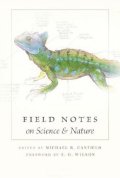
|
|
Listed: Dispatches from America's Endangered Species ActJoe Roam
Harvard University Press
2011
"The first listed species to make headlines after the Endangered Species Act was passed in 1973 was the snail darter, a three-inch fish that stood in the way of a massive dam on the Little Tennessee River. When the Supreme Court sided with the darter, Congress changed the rules. The dam was built, the river stopped flowing, and the snail darter went extinct on the Little Tennessee, though it survived in other waterways. A young Al Gore voted for the dam; freshman congressman Newt Gingrich voted for the fish. A lot has changed since the 1970s, and Joe Roman helps us understand why we should all be happy that this sweeping law is alive and well today. More than a general history of endangered species protection, Listed is a tale of threatened species in the wild - from the whooping crane and North Atlantic right whale to the purple bankclimber, a freshwater mussel tangled up in a water war with Atlanta - and the people working to save them. Employing methods from the new field of ecological economics, Roman challenges the widely held belief that protecting biodiversity is too costly. And with engaging directness, he explains how preserving biodiversity can help economies and communities thrive. Above all, he shows why the extinction of species matters to us personally - to our health and safety, our prosperity, and our joy in nature."
|
Buy from amazon.co.uk 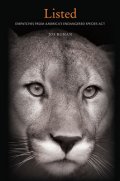
|
|
Engineering Animals: How Life WorksMark Denny and Alan McFadzean
Harvard University Press
2011
"The alarm calls of birds make them difficult for predators to locate, while the howl of wolves and the croak of bullfrogs are designed to carry across long distances. From an engineer's perspective, how do such specialized adaptations among living things really work? And how does physics constrain evolution, channeling it in particular directions? Writing with wit and a richly informed sense of wonder, Denny and McFadzean offer an expert look at animals as works of engineering, each exquisitely adapted to a specific manner of survival, whether that means spinning webs or flying across continents or hunting in the dark - or writing books. This particular book, containing more than a hundred illustrations, conveys clearly, for engineers and nonengineers alike, the physical principles underlying animal structure and behavior. Pigeons, for instance - when understood as marvels of engineering - are flying remote sensors: they have wideband acoustical receivers, hi-res optics, magnetic sensing, and celestial navigation. Albatrosses expend little energy while traveling across vast southern oceans, by exploiting a technique known to glider pilots as dynamic soaring. Among insects, one species of fly can locate the source of a sound precisely, even though the fly itself is much smaller than the wavelength of the sound it hears. And that big-brained, upright Great Ape? Evolution has equipped us to figure out an important fact about the natural world: that there is more to life than engineering, but no life at all without it."
|
Buy from amazon.co.uk 
|
|
The Nesting Season: Cuckoos, Cuckolds, and the Invention of MonogamyBernd Heinrich
Harvard University Press / Belknap Press
2010
"Why are the eggs of the marsh wren deep brown, the winter wren's nearly white, and the gray catbird's a brilliant blue? And what in the DNA of a penduline tit makes the male weave a domed nest of fibers and the female line it with feathers, while the bird-of-paradise male builds no nest at all, and his bower-bird counterpart constructs an elaborate dwelling? These are typical questions that Bernd Heinrich pursues in the engaging style we've come to expect from him - supplemented here with his own stunning photographs and original watercolors. One of the world's great naturalists and nature writers, Heinrich shows us how the sensual beauty of birds can open our eyes to a hidden evolutionary process. Nesting, as Heinrich explores it here, encompasses what fascinates us most about birds - from their delightful songs and spectacular displays to their varied eggs and colorful plumage; from their sex roles and mating rituals to nest parasitism, infanticide, and predation. What moves birds to mate and parent their young in so many different ways is what interests Heinrich - and his insights into the nesting behavior of birds has more than a little to say about our own."
|
Buy from amazon.co.uk 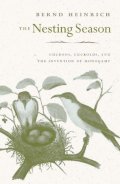
|
|
Evolution: The First Four Billion YearsEditor: Michael Ruse, Joseph Travis
Foreword: E.O. Wilson
Harvard University Press
2009
"Spanning evolutionary science from its inception to its latest findings, from discoveries and data to philosophy and history, this book is the most complete, authoritative, and inviting one-volume introduction to evolutionary biology available. Clear, informative, and comprehensive in scope, "Evolution" opens with a series of major essays dealing with the history and philosophy of evolutionary biology, with major empirical and theoretical questions in the science, from speciation to adaptation, from paleontology to evolutionary development (evo devo), and concluding with essays on the social and political significance of evolutionary biology today. A second encyclopedic section travels the spectrum of topics in evolution with concise, informative, and accessible entries on individuals from Aristotle and Linneaus to Louis Leakey and Jean Lamarck; from T.H. Huxley and E.O. Wilson to Joseph Felsenstein and Motoo Kimura; and on subjects from altruism and amphibians to evolutionary psychology and Piltdown Man to the Scopes trial and social Darwinism. Readers will find the latest word on the history and philosophy of evolution, the nuances of the science itself, and the intricate interplay among evolutionary study, religion, philosophy, and society."
|
Buy from amazon.co.uk 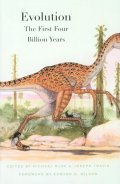
|
|
Audubon: Early Drawings
Introduction: Richard Rhodes
Annotation: Scott V. Edwards
Foreword: Leslie A. Morris
Harvard University Press
2008
"In 1805, Jean Jacques Audubon was a twenty-year-old itinerant Frenchman of ignoble birth and indifferent education who had fled revolutionary violence in both Haiti and France to take refuge in frontier America. Ten years later, John James Audubon was an American citizen, entrepreneur, and family man whose fervent desire to 'become acquainted with nature' had led him to reinvent himself as a naturalist and artist whose publication of "Birds of America" would soon earn him international acclaim. The drawings he made during this crucial decade, of specimens he collected in France and in America - now held by the Houghton Library and the Museum of Comparative Zoology at Harvard - are published together here for the first time in large format and full color. In these portraits, we watch Audubon invent his ingenious methods of posing and depicting his subjects, and we trace his development into a scientist and an artist who could proudly sign his artworks 'drawn from Nature.' The drawings are enhanced by an essay on the sources of Audubon's art by his biographer, Richard Rhodes; full transcription of Audubon's own annotations; ornithological commentary and an essay on Audubon's science by Scott V. Edwards; and an account of the collection's history by Leslie A. Morris. Splendid in their own right, these drawings also illuminate the self-invention of one of the most important figures in American natural history. They will delight and inform all those interested in American art, nature, birds, and the life and times of John James Audubon."
|
Buy from amazon.co.uk 
|
|
Egg & Nest Rosamond Purcell, Linnea Hall, Rene Corado
Introduction:Bernd Heinrich
Harvard University Press
2008
"The beauty of the robin's egg is not lost on the child who discovers the nest, nor on the collector of nature's marvels. Such instances of wonder find fitting expression in the photographs of Rosamond Purcell, whose work captures the intricacy of nests and the aesthetic perfection of bird eggs. Mining the ornithological treasures of the Western Foundation of Vertebrate Zoology, Purcell produces pictures as lovely and various as the artifacts she photographs. The dusky blue egg of an emu becomes a planet. A woodpecker's nest bears an uncanny resemblance to a wooden shoe. A resourceful rock dove weaves together scrap metal and spent fireworks. A dreamscape of dancing monkeys emerges from the calligraphic markings of a murre egg. Alongside Purell's photographs, Linnea Hall and Rene Corado offer an engaging history of egg collecting, the provenance of the specimens in the photographs, and the biology, conservation, and ecology of the birds that produced them. They highlight the scientific value for understanding and observing birds in the wild, as well as the aesthetic charge they carry for us.How has evolution shaped the egg or directed the design of the nest? How do the photographs convey such infinitesimal and yet momentous happenstance? The objects in "Egg and Nest" are specimens of natural history, and in Purcell's renderings, they are also the most natural art."
|
Buy from amazon.co.uk 
|
|
The Tree of Life: A Phylogenetic Classification
Guillaume Lecointre and Hervé Le Guyader
Harvard University Press
2007
"Did you know that you are more closely related to a mushroom than to a daisy? That crocodiles are closer to birds than to lizards? That dinosaurs are still among us? That the terms "fish," "reptiles," and "invertebrates" do not indicate scientific groupings? All this is the result of major changes in classification, whose methods have been totally revisited over the last thirty years. Modern classification, based on phylogeny, no longer places humans at the centre of nature. Groups of organisms are no longer defined by their general appearance, but by their different individual characteristics. Phylogeny, therefore, by showing common ancestry, outlines a tree of evolutionary relationships from which one can retrace the history of life. This book diagrams the tree of life according to the most recent methods of classification. Each branch of the tree is a group that includes the hypothetical ancestor and all its descendants. The basis for classification is the evolutionary adaptations that the unique ancestor passed to its modern-day descendants. By showing how life forms arose and developed and how they are related, "The Tree of Life" presents a key to the living world in all its dazzling variety."
|
Buy from amazon.co.uk 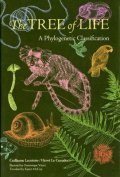
|
|
Bird Coloration, Volume 1: Mechanisms and MeasurementsEditors: Geoffrey E Hill and Kevin J McGraw
Harvard University Press
2006
"Geoffrey Hill and Kevin McGraw have assembled the world's leading experts in perception, measurement, and control of bird coloration to contribute to this book. This sumptuously illustrated volume synthesizes more than 1,500 technical papers in this field. The focus is on the three primary mechanisms of color production - melanin pigmentation, carotenoid pigmentation, and structural coloration - but less common as well as newly described mechanisms of color production are also reviewed in detail. The visual perception of birds and the best ways to collect and analyze color data are, for the first time, presented as part of the review of mechanisms of coloration."
|
Buy from amazon.co.uk 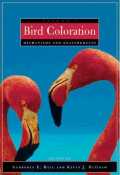
|
|
Bird Coloration, Volume 2: Function and EvolutionEditors: Geoffrey E Hill and Kevin J McGraw
Harvard University Press
2006
"In Volume 2, the authors turn from the problem of how birds see and produce colour and how researchers measure it, to what is the function of the colourful displays of birds and what are the factors that shape the evolution of colour signals. The contributors to this volume begin by examining the function of coloration in a variety of contexts from mate choice, to social signalling, to individual recognition, synthesizing a vast amount of recent findings by researchers around the world. The volume and the series conclude with chapters that consider coloration from an explicitly evolutionary perspective, examining selective pressures that have led to the evolution of colours and patterns on body and plumage. These functional and evolutionary studies build from research on mechanisms of production and controls of expression, covered in the previous volume, bringing the study of colour full circle."
|
Buy from amazon.co.uk 
|
|
Osteology for the ArchaeologistStanley J. Olsen
Harvard University Press
Papers of the Peabody Museum Volume 56, No. 3 to 5
Numbers 3: American Mastadon and the Woolly Mammoth
Numbers 4: North American Birds: Skulls and Mandibles
Numbers 5: North American Birds: Postcranial Skeletons
2004
"This comparative analysis aids the fieldworker in identifying fossil proboscidean bones from early man sites. It also describes the skulls, mandibles, and posteranial skeletons of forty families of birds frequently found in archaeological excavations in the United States."
|
Buy from amazon.co.uk 
|
|
More Than Kin and Less Than Kind: The Evolution of Family ConflictDouglas W. Mock
Harvard University Press
2004
"Among seals and piglets, storks and burying beetles, in bird nests and beehives, from apples to humans, family conflicts can be deadly serious, determining who will survive and who will perish. When offspring compete for scarce resources, sibling rivalry kicks in automatically. Parents sometimes play favourites or even kill their young. In "More than Kin and Less than Kind", Douglas Mock tells us what scientists have discovered about this disturbing side of family dynamics in the natural world."
|
Buy from amazon.co.uk 
|
|
British Naturalists in Qing China: Science, Empire and Cultural EncounterFa-ti Fan
Harvard University Press
2004
"Fa-Ti Fan examines the research of British naturalists in China in relation to the history of natural history, of empire and of Sino-Western relations. He gives a panoramic view of how the British naturalists and the Chinese explored, studied and represented China's natural world in the social and cultural environment of Qing China."
|
Buy from amazon.co.uk 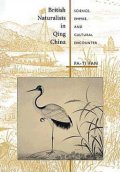
|
|
The Birder's Bug BookGilbert Waldbauer
Harvard University Press
2004
"When the first birds appeared on earth about 150 million years ago, the insects were here to greet them. Inevitably the two groups came to exploit each other, and as the eons passed, they became increasingly enmeshed in a complex web of interrelationships: birds eating bugs; blood-sucking insects feeding on birds; parasitic insects infesting birds; and birds struggling to rid themselves of the parasites. In this text, Gilbert Waldbauer describes these and many other interactions between birds and insects."
|
Buy from amazon.co.uk 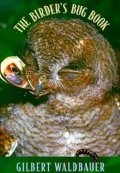
|
|
Songs, Roars & Rituals: Communication in Birds, Mammals & Other AnimalshLesley J. Rogers and Gisella Kaplan
Harvard University Press
2001
"From the calling macaw and the roaring lion to the dancing lyrebird, animals all around us can be heard and seen communicating with each other and, occasionally, with us. Why they do so, what their utterances mean, and how much we know about them are the subject of "Songs, Roars, and Rituals." This is a concise, yet comprehensive, introduction to the complexities of communication in animals. Rogers and Kaplan take us on an exciting journey through communication in the animal world, offering insights on how animals communicate by sight, sound, smell, touch, and even electrical signaling. They explore a wide variety of communication patterns in many species of mammals and birds and discuss in detail how communication signals evolved, how they are learned, and what song and mimicry may mean. An up-to-date account of the science of animal communication, this book also considers modern concepts (such as that of deceptive communication) and modern controversies, primarily those surrounding the evolution of human language and the use of symbolic language by apes. It concludes with a thought-provoking look at the future of communication between humans and animals."
|
Buy from amazon.co.uk 
|
|
Promiscuity: An Evolutionary History Of Sperm CompetitionTim Birkhead
Harvard University Press
2000
"Tim Birkhead reveals a wonderful world in which males and females vie with each other as they strive to maximize their reproductive success. Both sexes have evolved staggeringly sophisticated ways to get what they want--often at the expense of the other. He introduces us to fish whose first encounter locks them together for life in a perpetual sexual embrace; hermaphrodites who joust with their reproductive organs, each trying to inseminate the other without being inseminated; and tiny flies whose seminal fluid is so toxic that it not only destroys the sperm of rival males but eventually kills the female. He explores the long and tortuous road leading to our current state of knowledge, from Aristotle's observations on chickens, to the first successful artificial insemination in the seventeenth century, to today's ingenious molecular markers for assigning paternity. And he shows how much human behaviour - from the wife-sharing habits of Inuit hunters to Charlie Chaplin's paternity case - is influenced by sperm competition. Lucidly written and lavishly illustrated, with a wealth of fascinating detail and vivid examples, Promiscuity is the ultimate guide to the battle of the sexes"
|
Buy h/b from amazon.co.uk 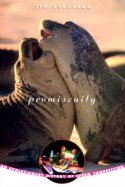
Buy p/b from amazon.co.uk

|
|
Animal Cognition: An Introduction to Modern Comparative PsychologyJacques Vauclair
Harvard University Press
1995
"Animal Cognition presents a clear, concise and comprehensive overview of what we know about cognitive processes in animals. Focusing mainly on what has been learned from experimental research, Vauclair presents a wide-ranging review of studies of many kinds of animals - bees and wasps, cats and dogs, dolphins and sea otters, pigeons and titmice, baboons, chimpanzees, vervet monkeys, and Japanese macaques. He also offers a discussion of the ways Piaget's theory of cognitive development and Piagetian concepts may be used to develop models for the study of animal cognition. Individual chapters review the current state of our knowledge about specific kinds of cognition in animals: tool use and spatial and temporal representations; social cognition - how animals manage their relational life and the cognitive organization that sustains social behaviours; representation, communication and language; and imitation, self-recognition and the theory of mind - what animals know about themselves. The book closes with Vauclair's 'agenda for comparative cognition'."
|
Buy from amazon.co.uk 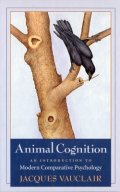
|
|
American Warblers: An Ecological and Behavioural PerspectiveD.H. Morse
Harvard University Press
1990
"A monograph on the New World Warblers. The author reviews their evolutionary history and their dispersal through North and South America, their life cycle, both in breeding and migration, as well as aspects of their foraging behaviour, habitat selection, mating, reproduction, plumage, rare and tropical species, and diversity."
|
Buy from amazon.co.uk
Buy from amazon.com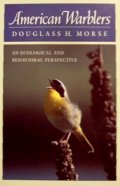
|
|
In a Patch of Fireweed: A Biologist's Life in the FieldBernd Heinrich
Harvard University Press
1984
"Why would a grown man chase hornets with a thermometer, paint whirligig beetles bright red, or track elephants through the night to fill trash bags with their prodigious droppings? Some might say-to advance science. Heinrich says-because it's fun. Bernd Heinrich, author of the much acclaimed Bumblebee Economics, has been playing in the wilds of one continent or another all his life. In the process, he has become one of the world's foremost physiological ecologists. With In a Patch of Fireweed, he will undoubtedly become one of our foremost writers of popular science. Part autobiography, part case study in the ways of field biology, In a Patch of Fireweed is an endlessly fascinating account of a scientist's life and work. For the author, it is an opportunity to report not just his results but the curiosity, humor, error, passion, and competitiveness that feed into the process of discovery. For the reader, it is simply a delight, a rare chance to share the perceptions of an unusual mind fully in tune with the inner workings of nature. Before his years of research in the woodlands and deserts of North America, the New Guinea highlands, and the plains of East Africa, Heinrich had a sense of the wild that few people in this century can know. He tells the whole story, from his refugee childhood hidden in a German forest, eating mice fried in boar fat, to his ongoing research in the woods surrounding his cabin in Maine."
|
Buy from h/b amazon.co.uk 
Buy from p/b amazon.co.uk

|
|
The Age Of BirdsAlan Feduccia
Harvard University Press
1980
|
Buy from amazon.co.uk 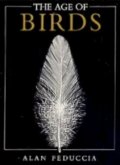
|
|
Ornithology: From Aristotle to the PresentErwinn Stresemann
Harvard University Press
1975
|
Buy from amazon.co.uk 
|
|
Ecological Isolation in BirdsDavid Lack
Illustrations: Robert Gillmor
Harvard University Press
1974
Published in the UK by Blackwell Scientific Publications.
|
Buy from amazon.co.uk 
|
|
Birds and Men: American Birds in Science, Art, Literature, and Conservation, 1800-1900Robert Henry Welker
Harvard University Press
1955
|
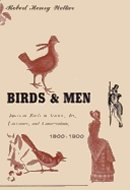 |
|
Check-list Of Birds Of The World: Volume VIIJames Lee Peters
Harvard University Press
1951
From the introduction: "With the exception of the Eurylaimidae, all the families in this volume have been monographed since 1923 and 1924. It is difficult to realize that more than 25 years have elapsed since the master ornithologist, C. E. Hellmayr, revised the Furnarioidea in a manner that fundamentally will stand the test of time. At the same time, Hellmayr's sound work provided a firm foundation upon which subsequent ornithologists could build with confidence. The extensive zoological explorations conducted in South America since the appearance of Hellmayr's volumes have greatly increased the ornithological knowledge of this continent, as attested by the numbers of new forms that have been named during the last quarter century, resulting in an increase of approximately 300 over the number of forms listed by Hellmayr."
|
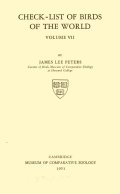 |
|
The Birds of Concord: A Study in Population TrendsLudlow Griscom
New England Bird Studies II
Harvard University Press
1949
|
Buy from amazon.co.uk 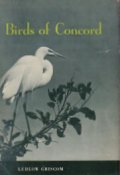
|
|
The Birds of NantucketLudlow Griscom and Edith V. Folger
New England Bird Studies I
Harvard University Press
1948
|
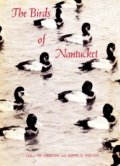 |
|
Check-list Of Birds Of The World: Volume VIJames Lee Peters
Harvard University Press
1948
From the introduction: "As stated in the introduction to Volume V, no major changes have been adopted in the general scope of this series."
|
 |
|
Modern Bird StudyLudlow Griscom
Harvard University Press
1945
|
Buy from amazon.co.uk 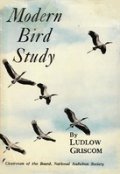
|
|
Check-list Of Birds Of The World: Volume VJames Lee Peters
Harvard University Press
1945
From the introduction: "No innovations have been adopted in this volume; the general scope, as outlined in the introduction to the first volume, with minor changes explained in the introductions to subsequent volumes, still stands. A little more than half of the present volume is taken by the hummingbirds. The arrangement of this family is essentially that adopted by Eugene Simon in his Histoire Naturelle des Trochilidae (Paris, 1921), but I have not been able to follow all of his generic refinements or some of his interpretations of the Rules of Zoological Nomenclature. Nevertheless, Simon's arrangement is probably the best to date for a family that defies any attempt at a logical linear classification. Generic differentiation has been much overdone in the Trochilidae; too much emphasis has been laid on secondary sexual characters of the males; a better system could probably be evolved from a classification based on the females, but the time element prevented my undertaking it."
|
 |
|
Check-list Of Birds Of The World: Volume IVJames Lee Peters
Harvard University Press
1940
From the introduction: "In the preparation of this volume I have attempted to adhere to the general plan originally outlined in the introduction to the first volume; no basic changes have been made in this scheme, but additional explanatory paragraphs have appeared in the introduction to volumes 2 and 3. The treatment of the orders dealt with in this volume has been brought up to 31 December 1938; a very few forms described early in 1939 are included, but no pretense has been made of keeping the work up to date after 1938. None of the included Orders has been completely monographed or listed since the turn of the last century; the Owls have been particularly neglected, and for this reason an unusually large amount of time was consumed in preparing a fresh arrangement."
|
 |
|
Check-list Of Birds Of The World: Volume IIIJames Lee Peters
Harvard University Press
1937
From the introduction: "The two orders treated in this volume have been the objects of special study on the part of many ornithologists during the past 150 years and the resulting literature is enormous. Among those who have contributed extensively are Kuhl (Parrots), Wagler (Parrots), Temminck (Pigeons), Bonaparte (Parrots and Pigeons), Reichenbach (Pigeons), Schlegel (Parrots and Pigeons), Finsch (Parrots) and Salvadori (Parrots and Pigeons). The two volumes of the Catalogue of Birds of the British Museum by Salvadori dealing with these orders have long been the standard, and after frequent renewed association with these volumes, I can say that in the care and thoroughness with which they were prepared and in the soundness of their writer's views they constitute a record of which anyone might be proud, and stamp their author as a truly great ornithologist."
|
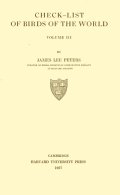 |
|
Check-list Of Birds Of The World: Volume IIJames Lee Peters
Harvard University Press
1934
From the introduction: "There is little to add by way of explanation to the second volume that is not mentioned in the introduction to the first. In response to a general demand I have given the vernacular names of families in the table of contents, but still adhere to my original stand that inventing common English names for birds that do not have them is a waste of time. After all, the primary reason for a scientific name is to have a name intelligible to scientists the world over."
|
 |
|
Check-list Of Birds Of The World: Volume IJames Lee Peters
Harvard University Press
1931
From the introduction: "It is now nearly thirty-two years since the first volume of Sharpe's Handlist of the Genera and Species of Birds made its appearance. The five volumes comprising that work have long been the one and only standard catalogue available to ornithologists, and it is a pity that Sharpe's work could not have remained so, but the rapidity of the increase of ornithological knowledge has made it clear for a number of years that a new work along the same, or perhaps shghtly more elaborate, lines was needed. The order of families and higher groups followed in this work is essentially the same as that proposed by Wetmore in the Proceedings XJ. S. National Museum, 76, Art. 24, 1930, pp. 1-8. The arrangement of the subfamilies and the sequence of genera and species have been compiled from many sources and from personal examination of material. The muchmooted question of generic limits is largely a matter of individual preference. In the recognition of genera I have endeavored to adhere to the doctrine that 'The genus should be used for expressing relationships,' and that minor structural differences should be considered as of specific value only, or at the most merely of subgeneric worth."
|
 |
|
The Migration Of BirdsAlexander Wetmore
Harvard University Press
1927
Preface: "The observations on the migration of birds presented in the following pages were delivered in six lectures before the Lowell Institute in Boston on October 26 and 28, and November 2, 4, 16 and 18, 1925. The manuscript as here published is unchanged except for the inclusion of a few paragraphs that time did not permit to be presented during the course of the lectures. The material included is based on study and observation on the part of the author during a period of more than twenty years. It is intended as a summary of present knowledge of migration, with the various factors that affect it in its broader aspects, without entering upon precise statistics of movement for the many species involved. Such figures may be left for treatises of another character. After careful consideration of the subject the writer is profoundly impressed by the mass of detail regarding the movements of birds that has been assembled and the little that has been definitely ascertained regarding the underlying principles that control migration. There is much that remains to be established in this phase of the subject. In conclusion the author desires to express appreciation to the Bureau of Biological Survey, United States Department of Agriculture, for permission to reproduce plates from its publications, and to the Museum of Vertebrate Zoology, University of California, for the privilege of reprinting a map by Mr. H. S. Swarth to show the distribution of fox sparrows. Mr. Gregory Mathews, the well-known authority on Australian birds, has read the sections dealing with Australia, and I am indebted to other friends for suggestions.
|

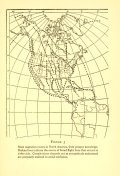 |
|